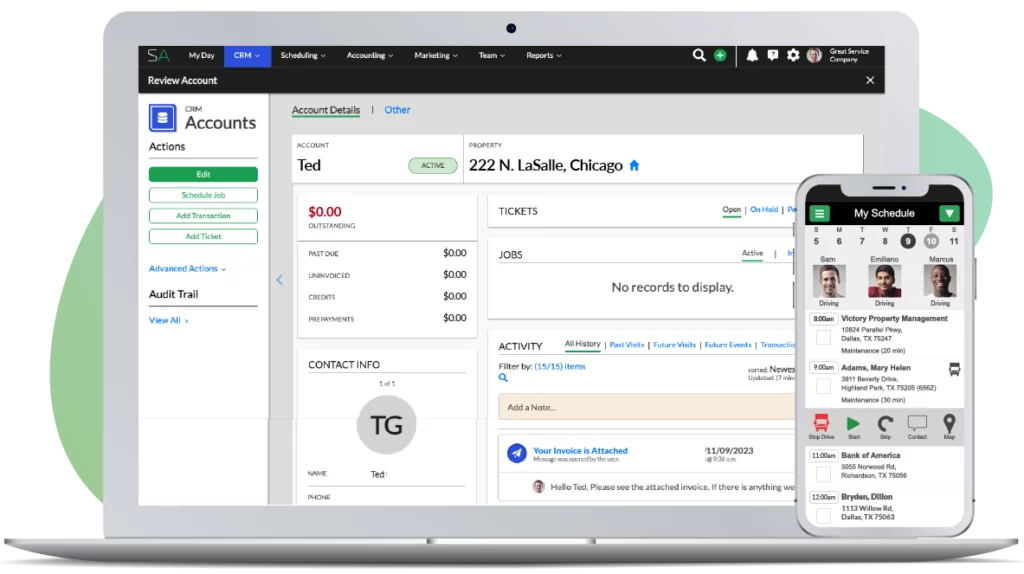In this video, Jonathan and Ryan tell us how to build a sales system to reproduce top sales performers.
Jonathan: Hey Ryan, why are you in my office today?
Ryan: Jonathan, I’m here to talk to you about sales.
Jonathan: All right, good. Well, you guys have been … I’ve learned a tremendous amount from you over the years of getting to know you and the team you work with. You guys, I mean, you run a pretty phenomenal operation. If you would, just so people know who you are, what’s the company you’re with?
Ryan: I’m Ryan Chipman. I’m with Schneider Shrub and Tree Care. We’re a shrub and tree care franchise out of South Carolina, offering to the South East.
Jonathan: Yeah, so Ryan was at our office. I’ve had the pleasure to work with Ryan and his team for a number of years now through Service Autopilot, and I have to say that they’ve been very influential. We’ve learned a lot from them, they’ve provided just this awesome advice. Ryan happened to be in town and I asked if we could shoot a couple videos to pass on some ideas to you. The thing that I’ve picked up from Ryan is you guys are really good at sales. Most companies that sell, they don’t really have a system around it. They hire sales people, and they send them out there, and they want them to sell. What I’ve observed with you guys is you have a plan, and you know how to hold people accountable. Tell me a little bit about what you’re doing.
Ryan: Well, about five years ago we decided that we needed a sales system for our team. We went to some consultants, we took ideas from other industries and put together a program that works really well at just what you said, holding people accountable to the activities they have to do on a regular basis to keep their sales consistent.
Jonathan: Did you have a sales team before you did this, or did you do this before you built the sales team?
Ryan: You know we’ve been in business for twenty years, so we’ve had a sales team for fifteen years prior to that.
Jonathan: Why’d you do this? Were you guys not seeing the results you thought you should see? What was the motivation?
Ryan: Well we’ve been growing over those fifteen years, and we knew that we wanted to take our growth to the next level. We had great production teams, and support teams. Our sales team was phenomenal and we were having challenges really growing the sales team because we had great people, and we couldn’t reproduce them. By having a sales program we’re able to take what those great people did, and reproduce that into new sales people so we can continue to grow that team.
Jonathan: What I know of your business is you guys set out goals, and you sit down frequently with the team, I think individually. Is that true, you do this individually? You set a goal with an individual in the sales team, and then you give them action items that are measurable.
Ryan: Yeah, actually each of our sales persons set their own goals because they’re commissioned based sales guys. They set the goal that they want to hit. Then we help to hold them accountable to meeting those goals through the activities that they’re doing, through following and tracking, which we use Service Autopilot for, for making sure that we’re giving them the support that they need to make sure they can go out and do all the activities they need to do.
Jonathan: One of the examples, and I think this is an incredibly good lesson, but I need you to elaborate on it. That is one of the things that I had learned from Ryan is, I feel like what you guys do is you say, “If you want to be successful, this is what success looks like. You’ve set this goal,” correct me if I’m wrong on this. “Mr. Sales person you’ve set this goal, and if you want to be successful then you need to make this many calls each week, you need to make this many … you need to get this many estimates out this week,” and you break it down to literally actionable items where they can look back at the end of the week and say, “Well I only did twenty and I was supposed to do forty, maybe that’s one of the reasons why I didn’t hit my goal.” Am I stating that correctly?
Ryan: Yeah, so every quarter we have a sales meeting where we sit down and we talk about what we’re going to do for the next quarter. We break down our goals based on what the sales goal is, what their average sale is, what their average close ratio is. Then we find out how many sales they need per week, and then how many estimates they’re going to need to meet those sales. Then we take and see what activity …
Jonathan: So if I could stop you there.
Ryan: Yeah.
Jonathan: Does that mean you’ve essentially figured out that for example, we close forty percent of our estimates, I’m making up a number, I don’t know what you guys close. You guys close forty percent of estimates, so that means that from that you can extrapolate how many estimates need to go out the door to generate X number of sales.
Ryan: Sure. Let’s say we have a hundred thousand dollars sales goal, your average sale’s a thousand bucks. You close fifty percent. Then you know how many estimates you’re going to need each week of that next quarter to hit your sales goal.
Jonathan: I’m going to guess then, and I know the answer because I’ve got to know you over time. From that if we need X number of estimates then you know how many leads you need to drive enough on site visits possibly to generate that number of estimates.
Ryan: That’s right.
Jonathan: Then that drives marketing and everything else. Would that be true?
Ryan: That’s right, and it’s different per sales guy. A guy that’s been in the business for fifteen years, he has a network of people that may generate … and especially in the busy season, more than enough to hit his goal. A new guy, he may have to go out and do cold calling, stop in’s, drop in’s, networking events, things that are going to drive those leads so that he can hit his sales goal.
Jonathan: Okay, yeah that makes a lot of sense. I feel like one of the things that most of us do, especially early on in the business is we’re just out there haphazardly trying to generate work and we’ve not put the thought in it like you guys have. That’s why we don’t build the businesses we want to build, we don’t see the success that we want to see, and it feels like everybody else that’s really successful is getting lucky. You guys are getting really crazy lucky. I mean …
Ryan: Well luck is mostly preparation.
Jonathan: It’s for this reason, I would argue, that you’ve systematized this. Is there anything you can say to maybe encourage somebody as to why they want to start thinking this way, why they want to sit down and spend the effort to essentially create these benchmarks or these actionable goals that they want to hit. What have you seen? You don’t have to give me specific numbers, but what kind of success have you seen since you transformed the business in this way?
Ryan: Well over the last five years we’ve seen thirty percent growth year over year.
Jonathan: At your size that’s pretty fantastic.
Ryan: Right, it is. It creates new challenges around production and things like that, but that’s always fun too. It allows us to add on sales guys. Somebody that may not be even from the sales industry. For example, one of our top guys right now that’s coming up came from the cellphone industry. He doesn’t know our industry, but you can teach him the techniques and tell him, “These are the tasks that you need to go do.” As long as he follows those tasks and goes and does those things, then he’s going to get the results.
Jonathan: That’s pretty awesome given how hard it is to find people in the industry.
Ryan: Yeah.
Jonathan: What would a ramp up time be for somebody like that when you’ve created an actual system? Is it a year?
Ryan: Depending upon where they’re coming from. A guy coming out of a similar industry, maybe a lawn care, landscaping company may have a network that allows him to ramp up in six months. A fresh guy, we’ve seen typically, can reach his goals in the first year. Then he can start really making the commissions, and really turning sales.
Jonathan: Would that be possible to do if you didn’t have the system where you said, “You need to be doing this many calls, you need to be visiting this many partners,” things of that sort?
Ryan: No, and that’s one of the reasons we really went to this system. The new guys we were bringing on were either not making it, or were taking two, three, four years to reach a commissionable sales rate.
Jonathan: Wow.
Ryan: Which was just really not feasible given the size of our company to absorb that.
Jonathan: Okay, so for anyone that’s not doing this, what would be maybe the first two steps to start moving in this direction?
Ryan: Step one, you’ve got to know your metrics. You have to know what your average sale is, what your close ratio is, and what marketing efforts are doing for you. How many leads are you getting from certain marketing efforts, that’s step one. Step two is, then setting the goals that you want to obtain and understanding what you’re going to do to fill in the gaps in your leads that you need. Then step three is, being accountable for it.
Jonathan: Okay, so one of my concerns would be that I feel that even with the great ideas, a lot of people would never even be able to do step one because they’re not tracking these items. How were you guys doing it? Is there an actionable piece of advice you can give somebody for step one?
Ryan: You got to use the system, right? Service Autopilot. We’re fully invested in that. That allows us to see what our close ratio is. It allows us to see what marketing efforts are doing, where our leads are generated, and it also allows us to see what our average sale is.
Jonathan: Okay, so once you’ve got that then, step two is you define a goal for the company as to where you want to go. “We accomplished X in maybe this year, and next year we want to accomplish Y.”
Ryan: Right.
Jonathan: In step two, basically you’re just figuring out what your goal is. Is that correct?
Ryan: Step two is goal setting. Yep.
Jonathan: Then you look at what you’ve done historically and figure out what you need to multiply that to achieve that goal.
Ryan: That’s correct.
Jonathan: Okay, anything else?
Ryan: The last thing is accountability. The glue that holds it all together. In our group we have a meeting every week where we talk to all of our sales team and we ask them, “Were you on track or off tack when it came to your actions this week? Did you make all your goals?” You can be on track one of two ways. You hit your sales number, which is always great. You did all the activities that you set out to do this week. Then you have to have accountability behind that.
Jonathan: Speaking of that, I got to visit your company several years ago and you guys … I got to sit in on one of your company meetings. I’d like to chat with you in another video about what you guys do from a meeting standpoint to encourage production, and sales, and everything else. That was pretty fantastic.
Ryan: Great.
Jonathan: Thanks Ryan.
Ryan: Thank you Jonathan.



